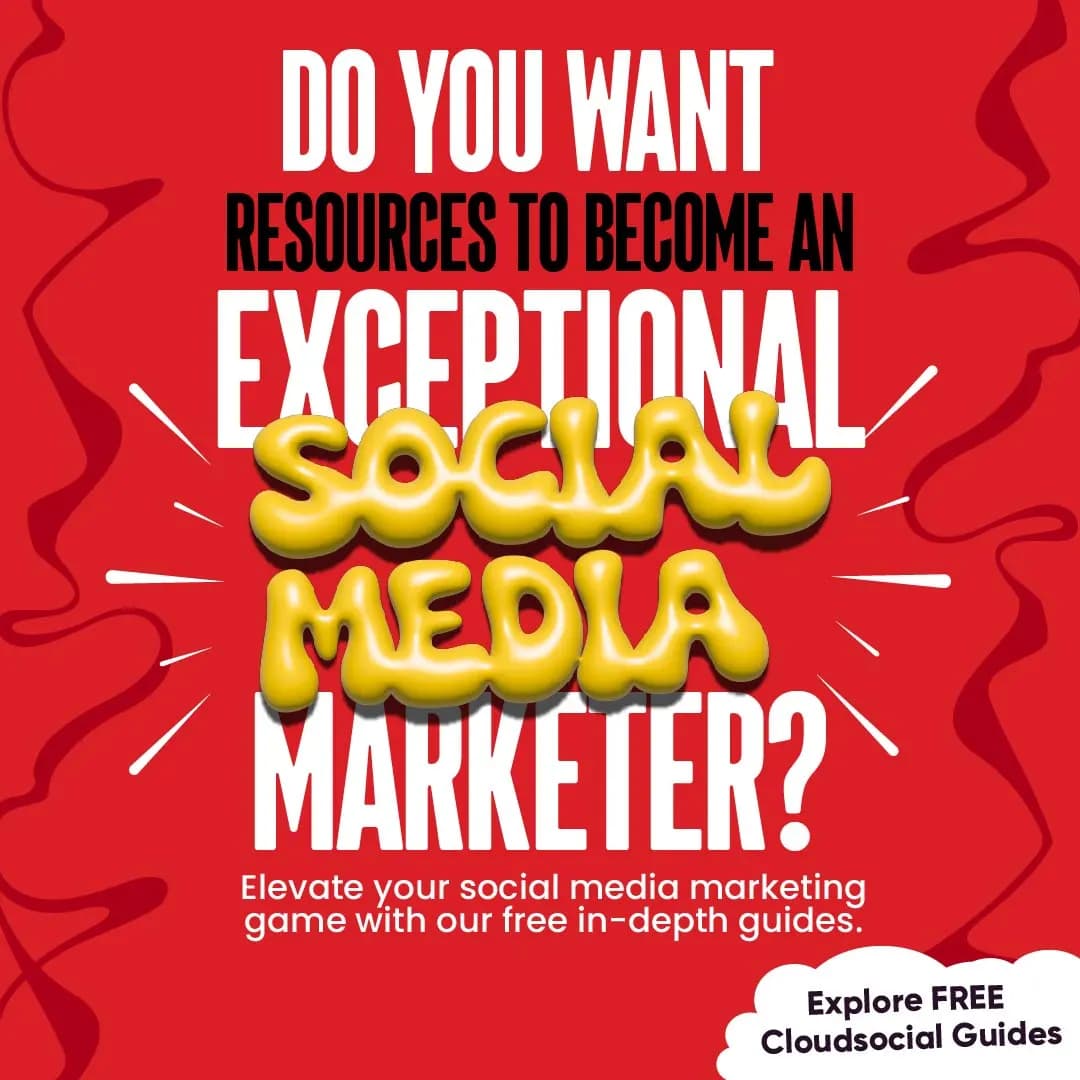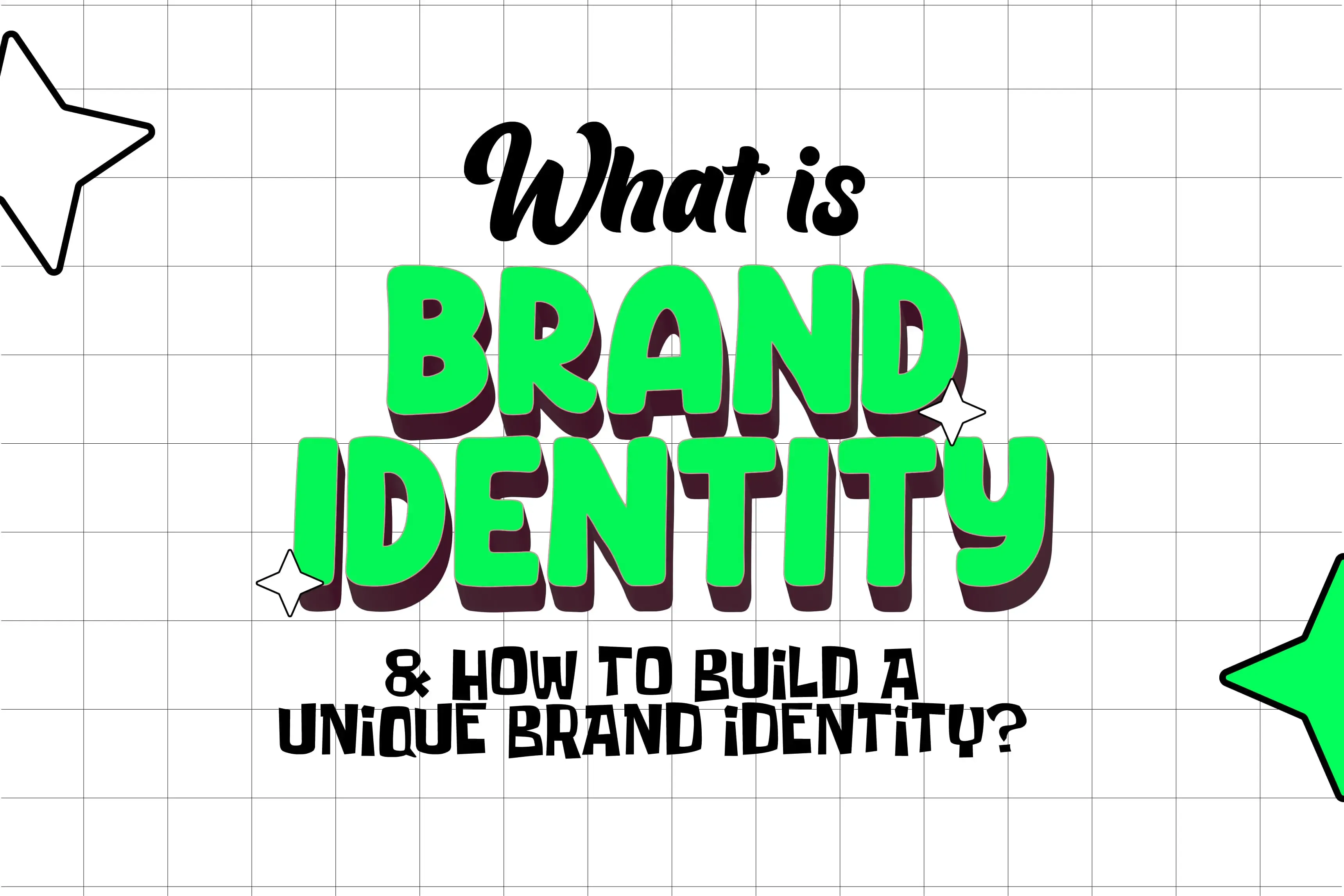
What is Brand Identity and How to Build a Unique Brand Identity?
Having a brand identity is more than just finding a logo to put on coffee mugs or a diary’s first page. Brand identity serves as the foundation of a brand's meaningful connections with customers.
A brand identity comprises what your brand says, your values, how you communicate your product, and what you want people to feel when they interact with your product and brand.
Having a brand identity is crucial today because customers now expect brands to nurture connections with their customers and bridge gaps between people with diverse perspectives.
According to a study, nearly 64% of consumers desire active communication from brands. This reveals that the relationship between a brand and its audience is not just transactional but involves a desire for engagement and interaction.
Brand Identity Can be Divided Into Two Parts
Visual identity
- Logo: A logo is more than just a visual mark; it's a succinct representation of your brand's essence. By employing colours, shapes, typography, and sometimes a tagline, an effective logo encapsulates your brand's identity and triggers positive emotions.
For example, a wordmark logo, which emphasises your company's name, is a powerful option when you want your name to take centre stage.
Put an image with these logos <Google Logo, FedEx, Coca Cola, Sony> with heading “Wordmark”.
On the other hand, if your brand's name is lengthy, considering a lettermark or a monogram logo might offer better visual appeal.
Put an image containing these logos <hp, VolksWagen, LG, h&m> with Headling “Monogram”.
Regardless of the logotype, the key is to ensure that it aligns with your brand's personality and resonates with your target audience.
- Colour: Selecting the right brand colours is a pivotal decision that will define your visual identity across all interactions. The choice of colours should not only be aesthetically pleasing but also functional and appropriate.
Whether it's the text on your website, your social media content, or printed materials, the chosen palette should seamlessly translate across diverse branding assets.
-
Typo (Font): Choosing the right typography for your brand isn't a one-size-fits-all decision. It's a strategic decision that can impact how your brand is perceived and remembered. It's about selecting fonts and arranging text in a way that reinforces the brand's identity, ensures effective communication, and leaves a lasting impression on the audience.
-
**Sound: ** Just as visual brand elements like logos and colours play a crucial role in brand recognition, sound elements add a sonic dimension to the overall brand experience. This includes music, jingles, sound effects, voice tones, and any other audio cues associated with the brand.
Think about the iconic sound of Intel's chime or the distinct tune of the Nokia ringtone – these are examples of brand sounds that have become instantly recognizable and are closely linked to the respective brands.
-
Styles: The appearance and tone of your business's visual identity are defined by a set of design principles and visual guidelines known as brand styles. Together, these components produce a unified aesthetic that is recognized and consistent across all brand touchpoints and resources.
-
**Imagery: ** Through skillful utilisation of images and videos, a brand can effectively convey its narrative, enriching its visual identity and fostering a stronger connection with its audience.
When curating imagery for platforms like your website or social media, meticulous attention to style, composition, and subjects is paramount. This diligence guarantees that your content maintains visual coherence, a cornerstone in crafting a branded and harmonious appearance.
- Brand Face: Many people find it challenging to connect with an impersonal and faceless brand. By incorporating a recognizable human figure into your branding efforts, you provide your audience with someone relatable and familiar, fostering a deeper resonance with your company.
For instance, A standout illustration of brand personality is embodied by The Colonel from KFC. This prime example showcases how a historical figure can evolve into a captivating brand mascot, resonating deeply with the audience.
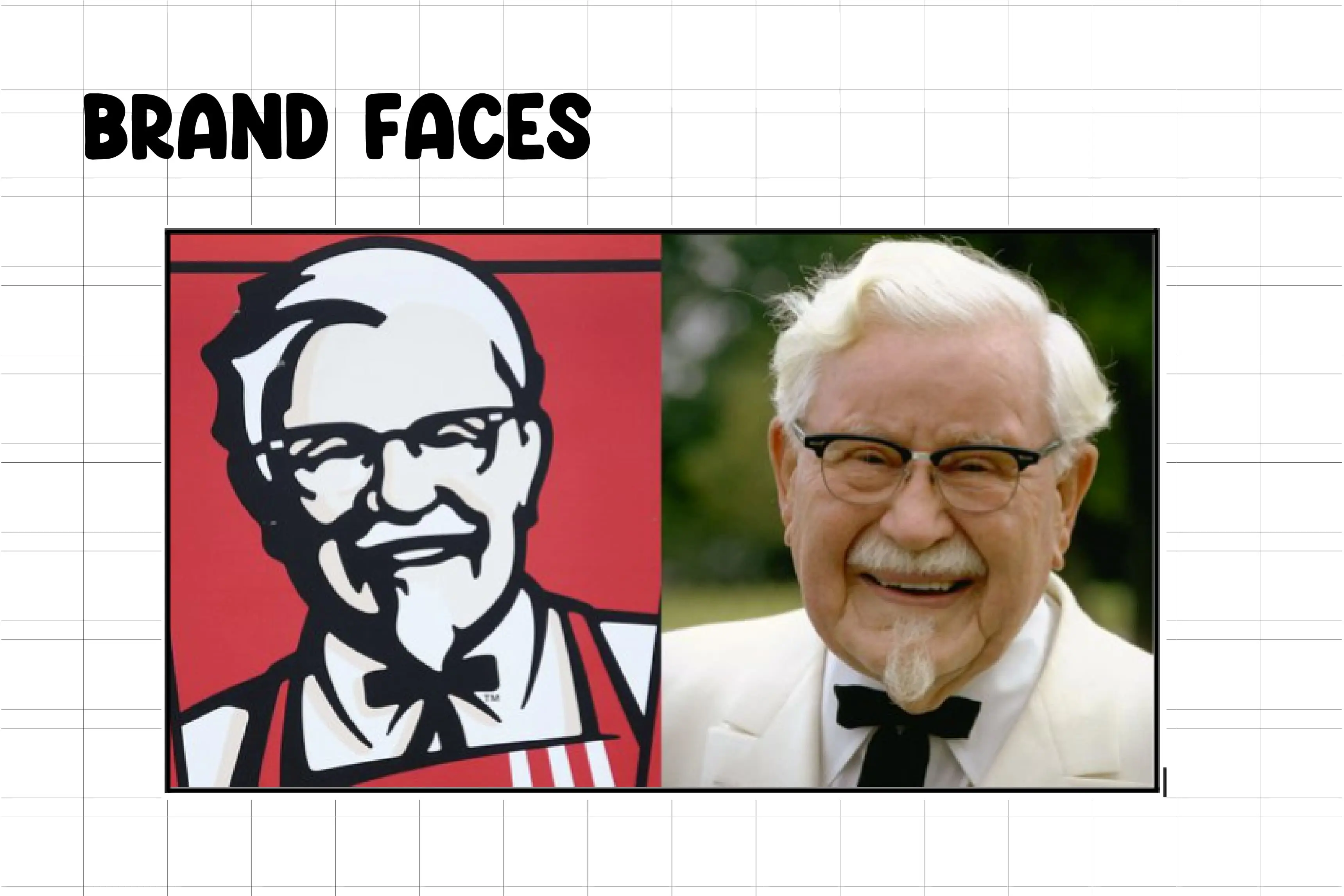
By giving The Colonel a persona and identity, KFC has crafted a compelling brand personality that extends beyond the food itself. The character conveys a sense of tradition, authenticity, and perhaps a hint of whimsy, enhancing the overall customer experience.
- **Characters: ** A brand character is a powerful tool to infuse your business with a distinct personality. Whether it's a cartoon figure, an animal, or an object, this character becomes an instantly recognizable and relatable representation of your brand.
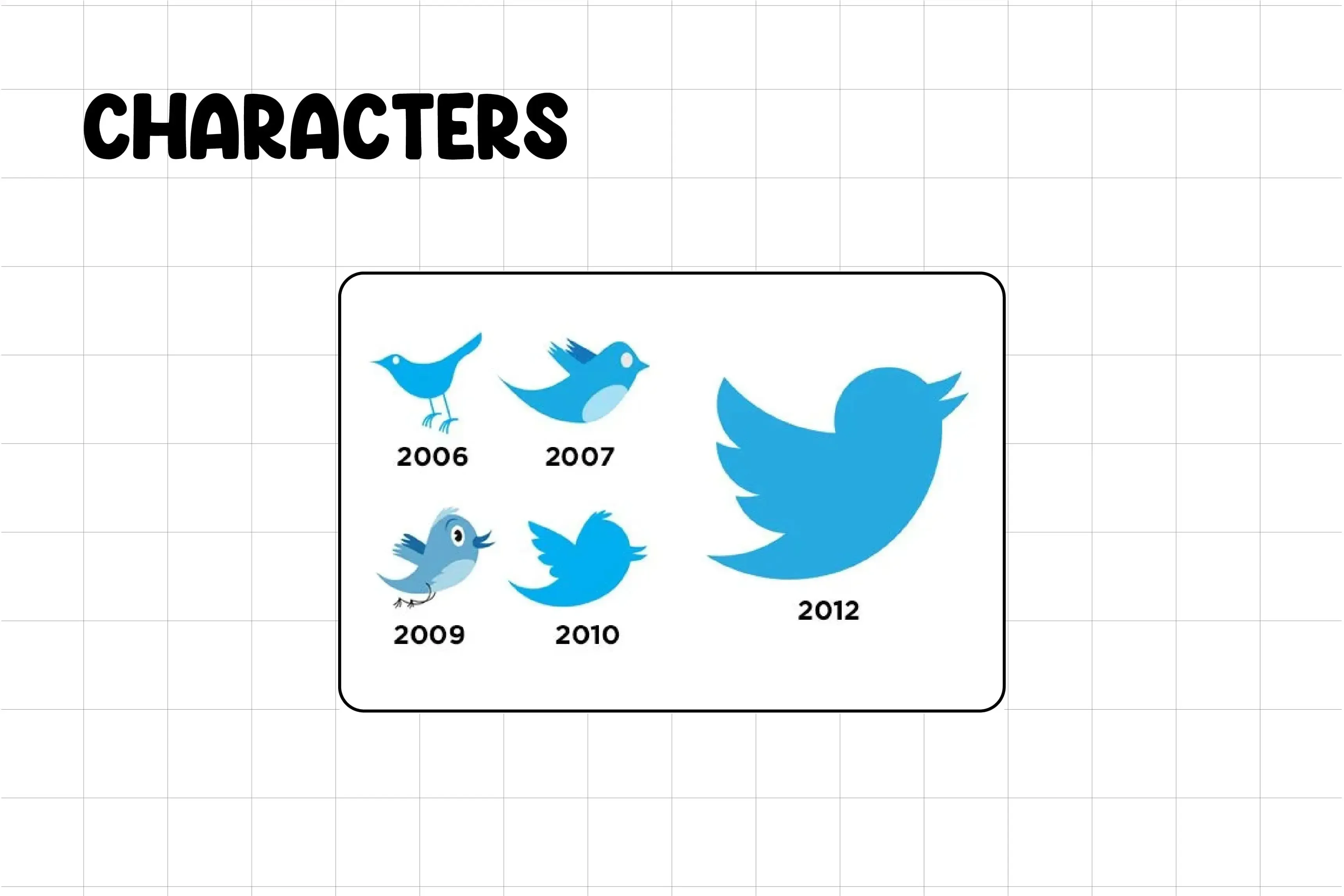
The evolution of Twitter’s brand character, Larry the Bird
Twitter's brand character, Larry the Bird, is a prime example of this concept in action. The brilliance of the bird logo lies in its versatility. It not only serves as a symbol for the website's branding but also seamlessly integrates into the corner of every individual tweet. This ubiquity makes the bird logo synonymous with the platform itself, effectively conveying the brand's identity without the need to spell out the name.
- Vectors/Illustrations: Brand vectors and illustrations are indispensable components of your brand's visual identity, serving as unique and stylistic extensions of your overall brand message. These visual brand elements encompass a range of forms, from minimalist lines and shapes to distinct icons, each carrying specific functions that resonate with your audience.
For example, icons and buttons strategically placed on your website have a direct impact on your customers' user experience, influencing their interactions with your brand. These brand elements guide navigation, enhance usability, and contribute to a cohesive online presence.
- Package/Product: A brand’s packaging is a powerful touchpoint for creating a meaningful connection with your customers. The physical wrapping or container in which your product is packaged carries a story—a story of your brand's values, personality, and quality. It's an extension of your brand experience that can evoke emotions and communicate messages even before the product is revealed.
In fact, studies reveal that a significant 40% of online shoppers consider branded packaging a compelling factor that influences their likelihood to recommend a product. This statistic underscores the impact that well-crafted packaging can have on customer perception and engagement.
Messaging
Brand messaging involves carefully crafting the tone of voice, language, and core message to convey the essence of your brand, its mission, and its unique value proposition.
- Tagline: A brand tagline is a concise and catchy statement that is an integral part of a brand's messaging strategy. It is designed to swiftly convey a clear idea of what the brand brings to the public. Incorporating a brand's personality, target market, and communication approach, the tagline plays a pivotal role in encapsulating the essence of the brand.
As seen in examples like Nike's "Just do it," AT&T's "Your world delivered," Tylenol's "Feel better, Tylenol," and Red Bull's "Red Bull gives you wings," these slogans create immediate associations with their respective brands, forming a bridge between the brand's identity and what it offers. Create a chart and mention taglines for each. Nike: Just do It AT&T: Your world delivered Tylenol: Feel better, Tylenol Red Bull: Red Bull gives you wings
- **Mission / Vision: ** A brand's vision outlines what the brand aims to achieve or become in the future, often reflecting its core values and differentiating qualities. An effective vision statement should be inspiring, and ambitious, yet grounded in reality. On the other hand, a brand's mission statement clarifies what the brand does, how it does it, and why it matters. A well-crafted mission statement and vision communicate the brand's unique selling point and the benefits it offers to its target audience.
For example, Google's vision of providing access to the world's information with one click illustrates a clear and inspiring long-term goal. This vision has been instrumental in guiding Google's development of innovative products and services that prioritize information accessibility and user convenience.
- Personality: Brand personality shapes how people perceive a company and evokes emotions. It drives positive actions from consumers and is relatable when similar to their traits. There are five main types of brand personality: Excitement, Sincerity, Ruggedness, Competence, and Sophistication.
For example, Nike's excitement-driven personality, ‘Just Do It’ appeals to motivate athletes, using bold visuals and inspirational messaging.
- Values: Brand values are the fundamental beliefs that a brand embraces and consistently follows in its endeavours to fulfil its mission. These values represent the actionable steps or behaviours that the brand adheres to to accomplish its objectives.
For instance, consider the brand value of "Transparency." This value might entail a guiding principle of proactively communicating with customers about the origin and manufacturing process of the brand's products. This commitment to transparency could extend further by openly publishing the brand's pricing strategy, demonstrating a genuine effort to share important information with customers.
Integrate These Brand Messaging Pillars into Your Brand Identity
Once you’ve clearly defined all these branding factors, it's important to integrate them into your brand messaging pillar framework.
Brand pillars, also referred to as company or messaging pillars, form an integrated framework encapsulating a brand's essence, distinctiveness, and communication strategy. They are integral to a comprehensive brand strategy, answering fundamental questions about the brand's purpose, perception, uniqueness, and engagement.
- **Purpose: ** The purpose pillar defines why a brand exists beyond profitability. It serves as a guiding light for internal stakeholders and drives the brand's actions.
Purpose-driven brands build deep connections with customers who value the brand's genuine commitment. Brands like TOMS, with its "One for One" ethos, exemplify this pillar by intertwining their mission with their products.
-
Positioning: Positioning determines the unique space a brand occupies in customers' minds compared to competitors. Effective positioning differentiates a brand and helps customers recognize its distinct value. Apple's positioning as an innovative and user-friendly tech brand exemplifies precision positioning, carving a niche that competitors struggle to replicate.
-
Personality: Brand personality adds human-like traits and emotions to the brand's character. It resonates with customers on a relatable level, contributing to a strong emotional connection. Brands like Nike maintain a powerful personality that inspires and empowers customers through their messaging and experiences.
-
**Perception: ** Brands actively shape customer perceptions through their purpose, positioning, and personality. Disney, for instance, consistently creates magical experiences that enhance its perception as a source of joy and entertainment.
-
**Promotion: ** Brand promotion encompasses strategies to engage, captivate, and motivate customers to connect with the brand. It goes beyond product promotion, aiming to build brand loyalty and equity. Effective brand promotion occurs through strategic communication, creating memorable stories that resonate with customers. Brands like Red Bull excel at promoting their brand through extreme sports events, linking their energy drink with adventurous experiences.
To effectively evaluate your brand messaging, consider the following checklist:
-
Alignment with Pillars: Is your overall brand message drawing from the key elements identified in each messaging pillar? Ensuring that your message is rooted in these foundational aspects reinforces the core identity of the brand.
-
**Consistency with Brand Voice: ** Is your message being conveyed in a manner that reflects your brand's distinctive voice and personality? A consistent tone reinforces brand recognition and authenticity.
-
Completeness of Messaging: Are there any crucial aspects missing from your messaging? Assess whether your content addresses all the relevant messaging pillars to create a comprehensive and well-rounded representation of the brand.
-
**Clarity and Consistency of Values: ** Are your brand's values and identifiers clearly articulated and consistent across all content? Ensuring that these core elements are evident fosters a strong connection with your audience.
Incorporating these considerations when evaluating brand messaging ensures that your content remains faithful to your brand's essence, effectively communicates your brand voice, and aligns with your overarching strategy. By adhering to these principles, you enhance the impact and effectiveness of your brand messaging efforts.
Successful Brands and Their Identities
Let’s have a look at some of the successful brand identities that have attracted and retained customers, fostered loyalty, and differentiated themselves from competitors in the market.
Coca-Cola
Coca-Cola is a well-known beverage company with a unique brand identity. Coca-Cola's brand visual identity is anchored in its rich history and enduring appeal. It is recognized for its iconic red logo and curving script. The company's messaging is focused on joy, community, and relaxing moments, which is represented in its enduring tagline, "Open Happiness."
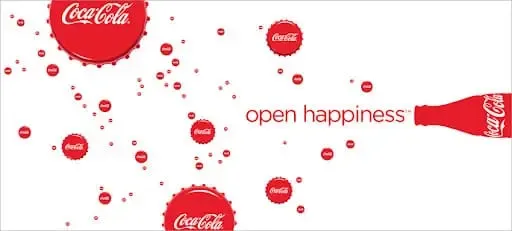
The brand “face” has become associated with festivities, sharing, and taking delight in life's simple pleasures as a result of its constancy in providing a revitalizing and uplifting experience.
Dove
Dove, a prominent name in the personal care industry, has established a remarkable branding example that revolves around more than just skincare and beauty products. Its brand elements have cultivated an aura of trust and credibility that extends beyond its merchandise.
Dove’s Real Beauty Tagline is a powerful message signifying self worth among women
For instance, the iconic Dove logo, a simple silhouette of a dove in flight, symbolises purity and peace, aligning with the brand's values of natural beauty and care. Coupled with powerful taglines like "Real Beauty" and "Choose Beautiful," Dove's brand messaging empowers individuals to embrace their uniqueness and make choices that reflect their self-worth. By challenging narrow beauty standards and embracing inclusivity, Dove's mission transcends mere commerce, positioning the brand as an advocate for positive change.
McDonald's
With a history spanning decades, McDonald's, a fast-food brand, has established a reputation for trust and credibility through consistent quality and service across its numerous locations.
McDonald’s brand elements like the brand logo, featuring the famous golden arches, are some of the most recognizable symbols worldwide. It symbolises familiarity, convenience, and comfort, reinforcing the brand's commitment to delivering a consistent experience.
Taglines have played a significant role in McDonald's messaging strategy. The enduring "I'm Lovin' It" tagline encapsulates the joy and delight associated with the brand while evolving over time to reflect changing consumer attitudes.
McDonald's brand identity is characterised by consistency, convenience, and community. Its iconic logo, recognizable taglines, and commitment to quality contribute to building trust and credibility among consumers worldwide. Through its distinctive approach and widespread presence, McDonald's has created a unique brand identity that transcends borders and cultures.
Red Bull
Red Bull is a globally recognized brand with a unique identity built on trust, credibility, and innovation in the energy drink market. Red Bull's iconic logo and taglines like "Red Bull Gives You Wings" are instantly recognizable. This consistency in branding contributes to the brand's strong identity and recall. The brand's face is further enhanced by its affiliation with extreme athletes, showcasing its commitment to pushing boundaries and achieving extraordinary feats.
 Image source
Image source
At the core of Red Bull's identity is its mission to inspire, energise, and ignite a sense of adventure. This mission aligns with its brand identity, fostering a sense of motivation and empowerment among its customers.
Nike
Renowned for its iconic "swoosh" logo, Nike, a global powerhouse in sportswear and athletics, has become synonymous with excellence and athletic achievement.
The brand's trust and credibility are earned through decades of delivering high-quality products that athletes and consumers alike rely on. Nike’s brand face is often associated with legendary athletes like Michael Jordan and Serena Williams, who become symbols of aspiration and determination, reflecting Nike's ethos of pushing limits and striving for greatness.
 Image Source
Nike’s brand logo, the simple yet impactful swoosh, encapsulates movement, energy, and progress, making it a cornerstone of Nike's visual identity. Its taglines, like "Just Do It," resonate deeply, capturing the essence of Nike's mission. This memorable tagline motivates and empowers people to take action and overcome challenges.
Image Source
Nike’s brand logo, the simple yet impactful swoosh, encapsulates movement, energy, and progress, making it a cornerstone of Nike's visual identity. Its taglines, like "Just Do It," resonate deeply, capturing the essence of Nike's mission. This memorable tagline motivates and empowers people to take action and overcome challenges.
Nike's mission, "To bring inspiration and innovation to every athlete in the world," demonstrates its commitment to continuous improvement and pushing boundaries. This mission aligns with its brand identity by driving innovation and setting new industry standards.
A case study of a Coca-Cola brand
Coca-Cola is a great branding example that is synonymous with happiness, sharing, and refreshment. Its brand elements like smiling, red-labelled bottles, and joyful depictions in advertisements reinforce this emotional connection, making it more than just a beverage but a symbol of positive experiences and connections.

Coca Cola Color Red Branding depicting Excitement and Passion
-
Logo: The brand logo, a scripted font spelling "Coca-Cola," holds significant weight in representing the brand identity. Its timeless design maintains a strong link to the company's history, while also adapting to modern times. The logo's design consistency across cultures and languages reinforces the brand's global presence and recognition.
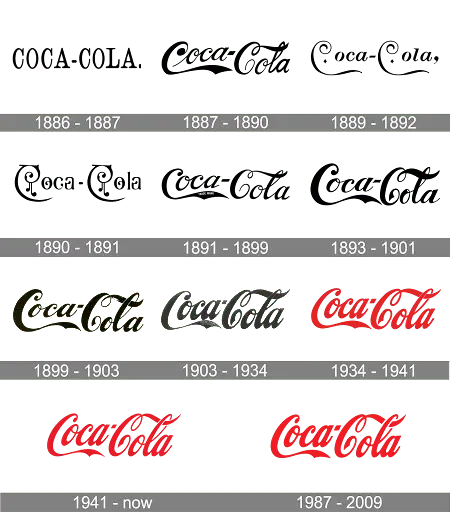 Coca-Cola branding evolution
Coca-Cola branding evolution -
Tagline: Coca-Cola's tagline, "Together Tastes Better," reflects its brand identity and core values in a multifaceted manner. It signifies a sense of connection, community, and togetherness that the brand aims to embody. This tagline reinforces the brand's trust and credibility, as Coca-Cola has been a staple beverage choice for generations. Through various advertising impressions, Coca-Cola has effectively positioned itself as a beverage that accompanies shared moments and brings people.
 Coca tagline “Together Tastes Better” promoting happiness and meaningful connections
Coca tagline “Together Tastes Better” promoting happiness and meaningful connections -
**Vision: ** Coca-Cola's vision revolves around the concept of "happiness," which is at the core of its brand identity. Coca-Cola aligns itself with feelings of happiness, creating a strong emotional connection with consumers. Its Advertising impressions, often delivered through multimedia campaigns, reinforce Coca-Cola's happiness-focused brand identity. These impressions showcase moments of joy, togetherness, and celebration, which resonate with the audience and further solidify the brand's image as a purveyor of happiness.
-
**Packaging: ** Coca-Cola's unique glass bottle packaging is a cornerstone of its brand identity, symbolising the brand's trustworthiness, credibility, and enduring legacy. The glass bottle's unique design has also become one of the most recognizable branding examples worldwide. Its contour shape, embossed logo, and vibrant red colour scheme contribute to a strong brand visual identity. This visual identity encapsulates the essence of Coca-Cola – its refreshing taste, rich history, and cultural impact.
Connect and Advertise Your Brand Identity on Social Media
Once you've established your brand identity, it's time to connect and advertise it effectively on social media to enhance your brand's trust, credibility, and recognition. Social media platforms offer valuable digital space for establishing your brand's identity. By using consistent messaging, visuals, and engagement across various platforms, you can reinforce your brand's identity. Consider how Starbucks maintains a consistent brand identity across its social media platforms. Its posts often revolve around cosy and inviting imagery, reinforcing its identity as a place to relax and enjoy quality coffee.
Connecting and advertising your brand on social media involves creating quality content, using appropriate language, fostering emotional connections, and utilising effective advertising strategies. These practices must align with your brand's identity, enhance its trust and credibility, and contribute to a strong online presence that resonates with your target audience.
For instance, during its fall beverage campaign, Starbucks communicates its brand on social media through captivating imagery of their seasonal drinks in iconic Starbucks cups against warm backdrops. This way, they maintain a consistent visual identity that resonates with followers. Accompanying captions tell stories of craftsmanship and the joy of having these drinks on crisp autumn days, forging an emotional connection.
With a campaign-specific hashtag like #FallForStarbucks, Starbucks encourages user-generated content, fostering a sense of community. The limited-time availability of these beverages creates a sense of urgency, prompting customers to indulge before the season ends.
Starbucks' active engagement with comments and user stories strengthens the bond, portraying Starbucks not just as a coffee provider but as a creator of comforting, seasonal experiences eagerly awaited by its diverse and dedicated customer base.
Conclusion
Are you thinking of starting your own brand on social media? We've got something that can help you make it great!
CloudSocial is a social media management tool that makes your social media presence better and easier. Not only does it offer a range of features designed to simplify and enhance your social media branding experience, but you’ll also be able to manage your posts, engage with your audience, and maintain a consistent brand identity effortlessly with its easy-to-use tools and valuable insights.
Take the next step and explore how CloudSocial can empower your brand today! Give it a try by visiting our website or using 30 days free trial version. Let's make your brand shine on social media together!
